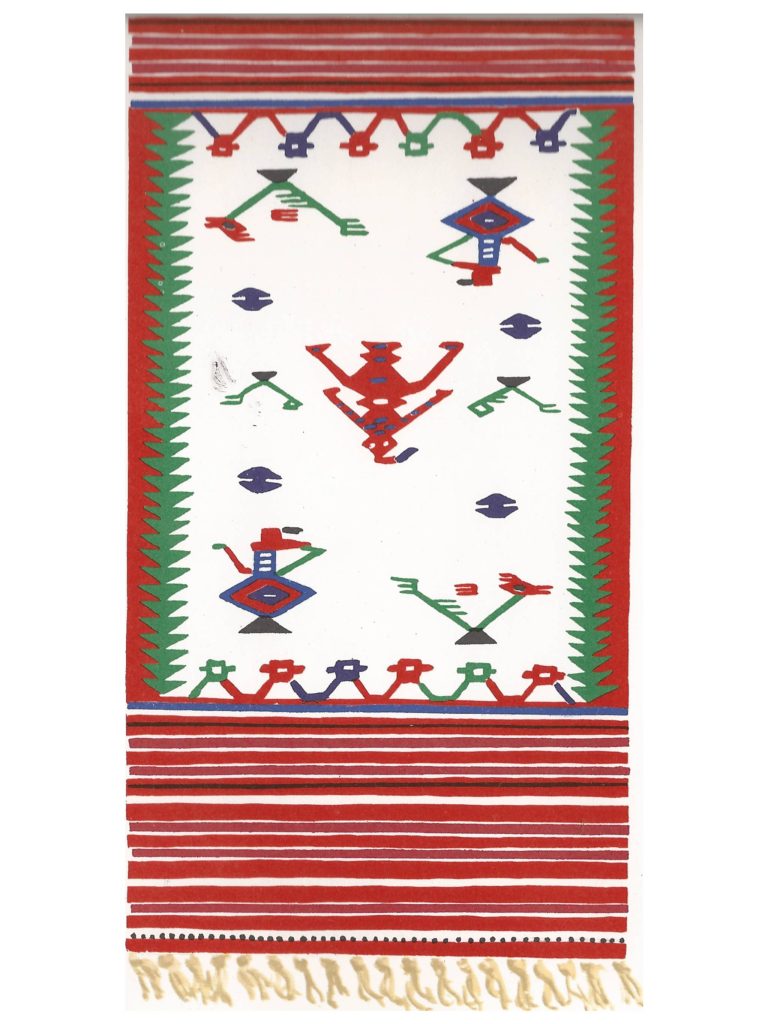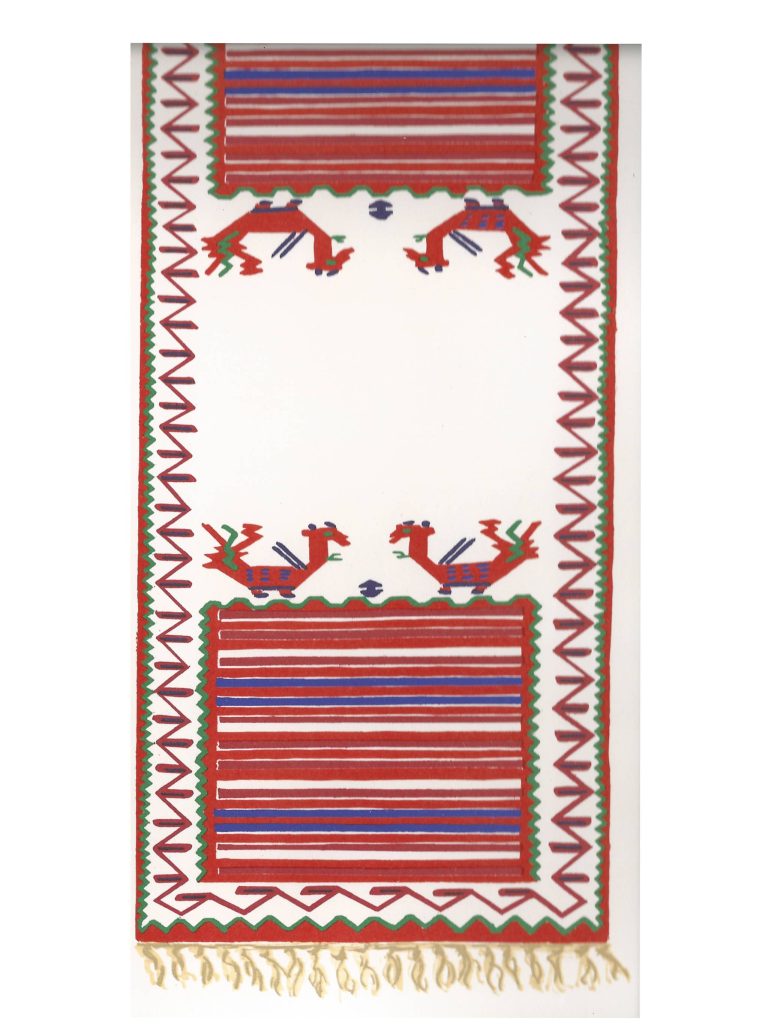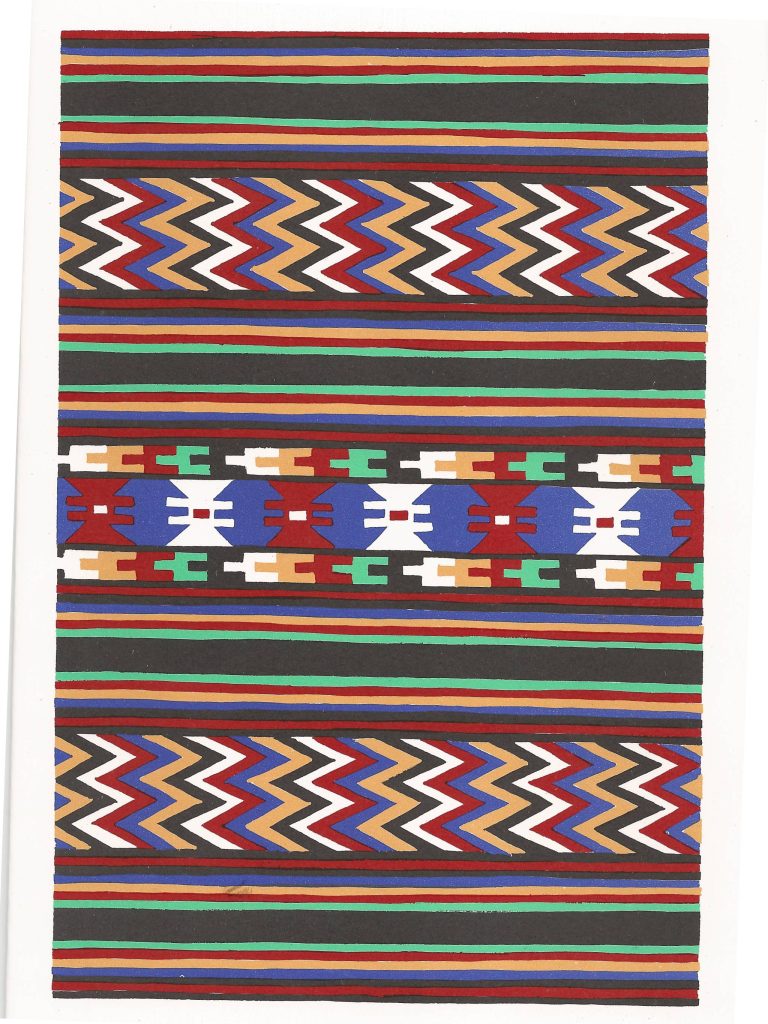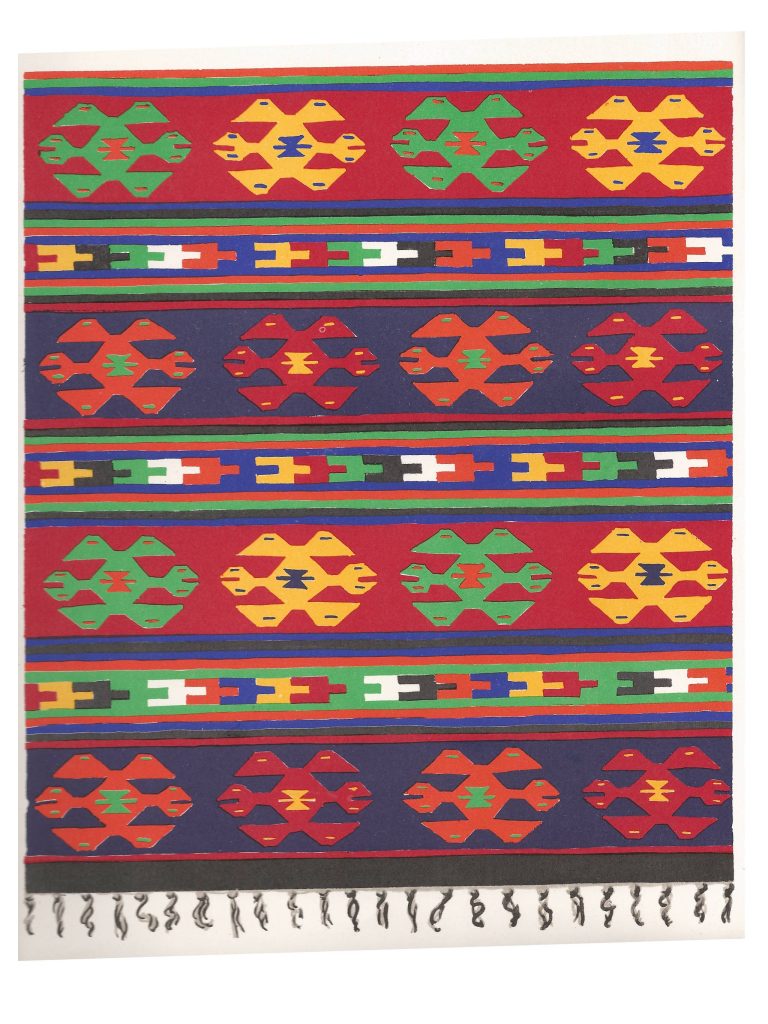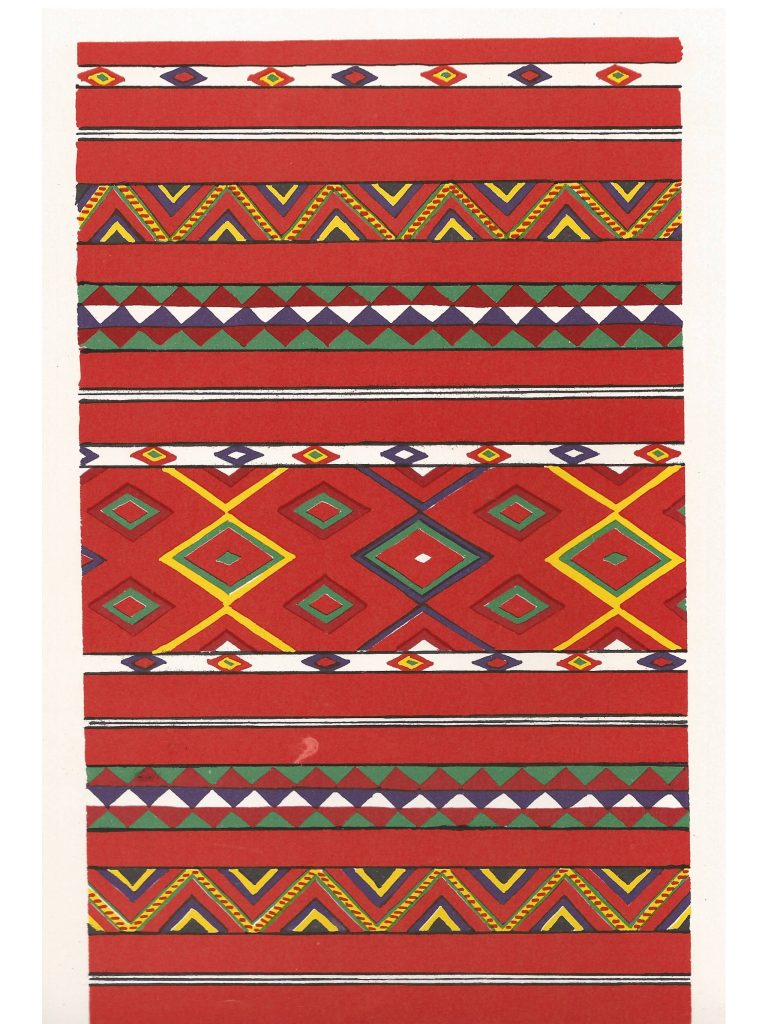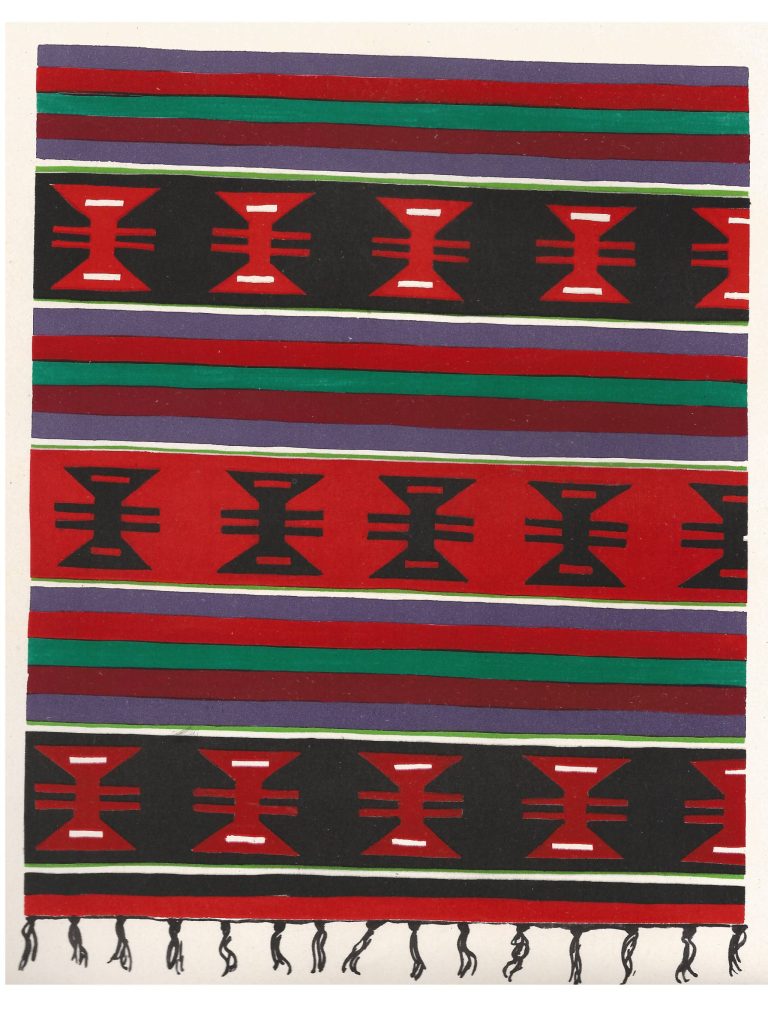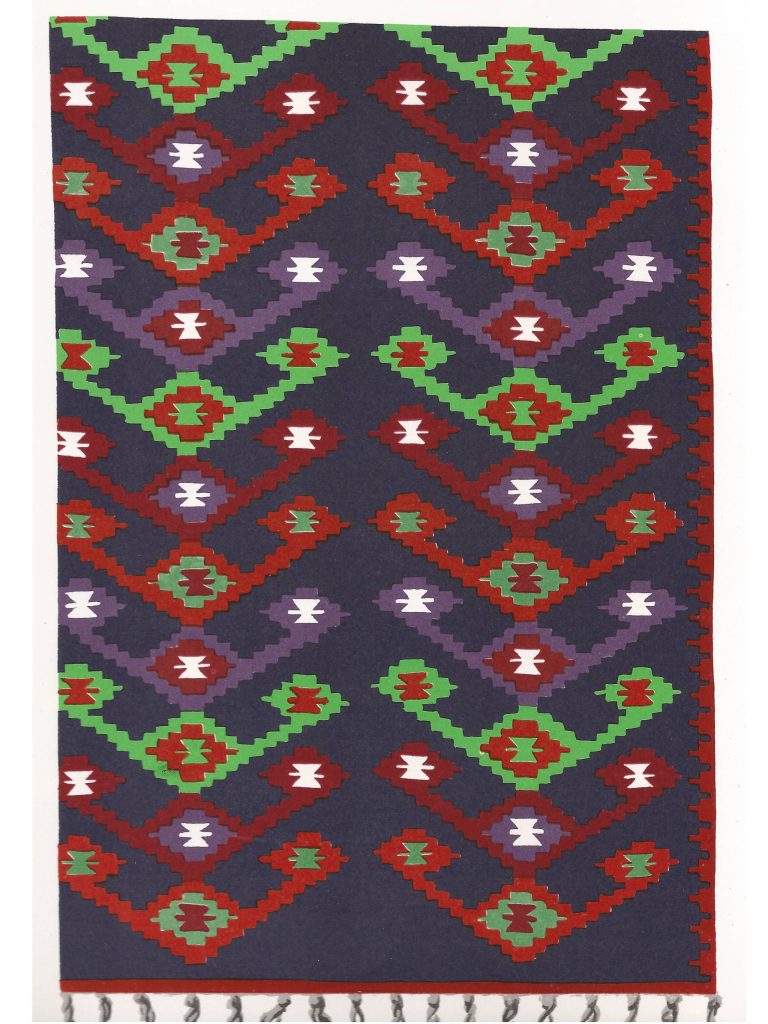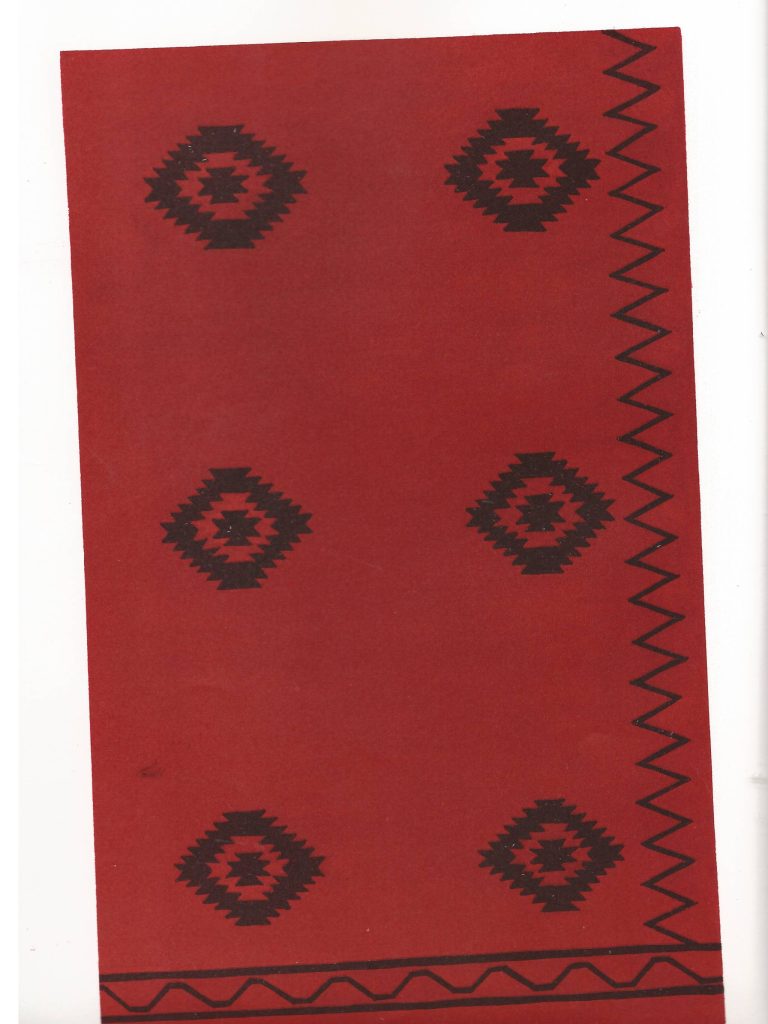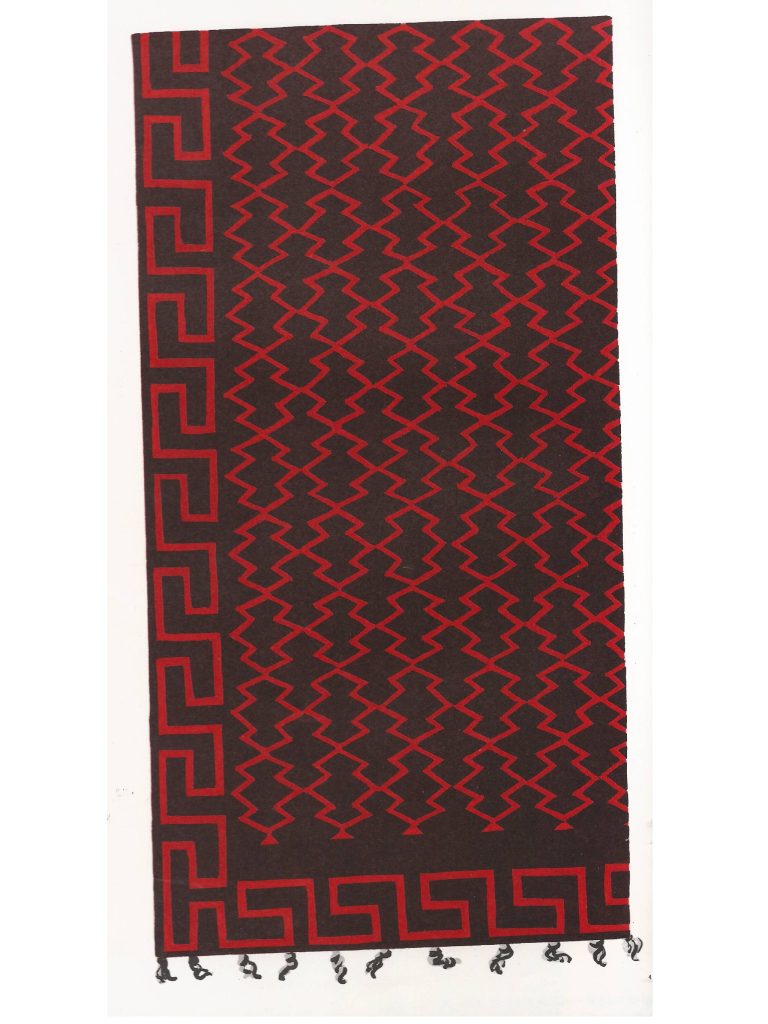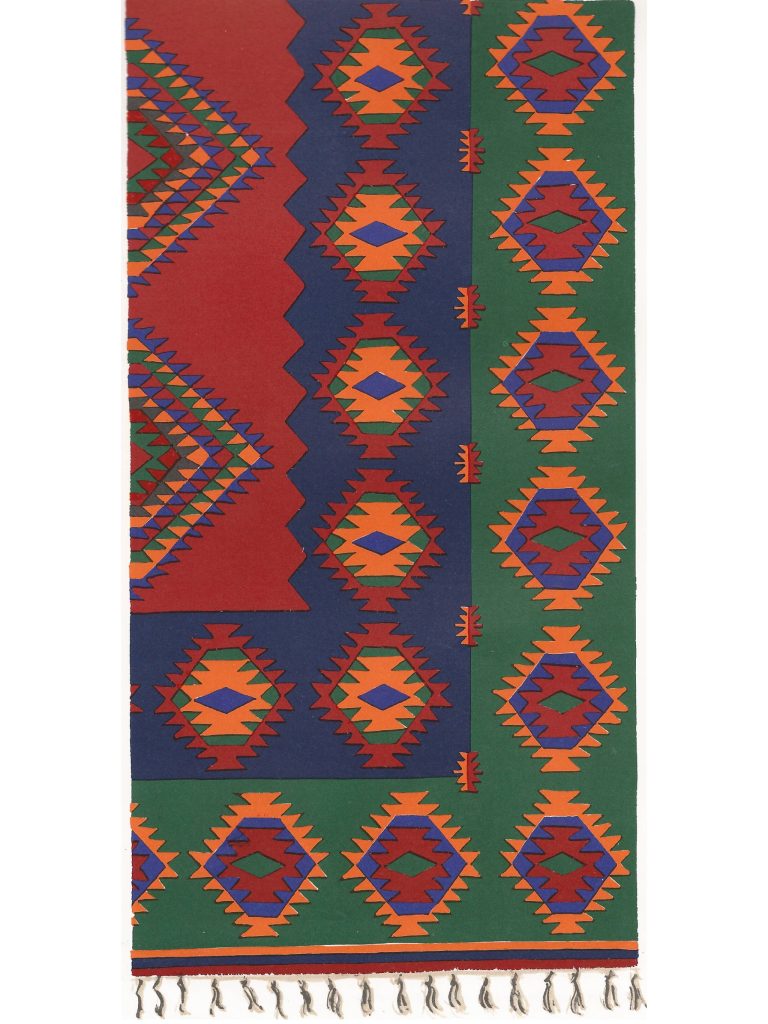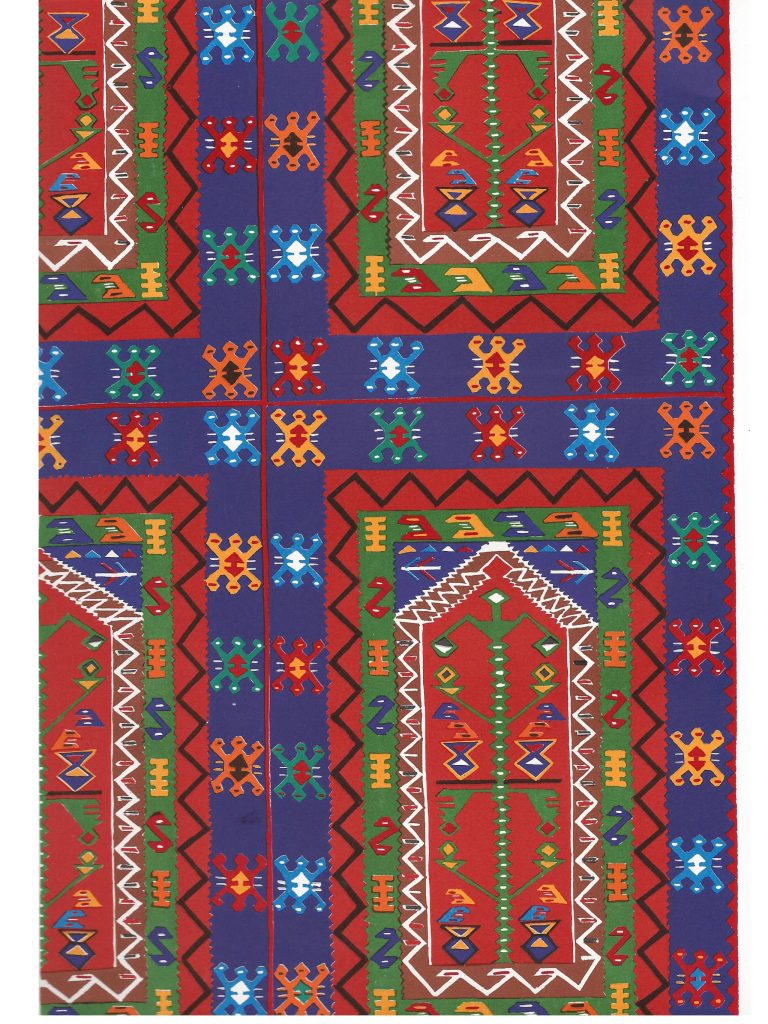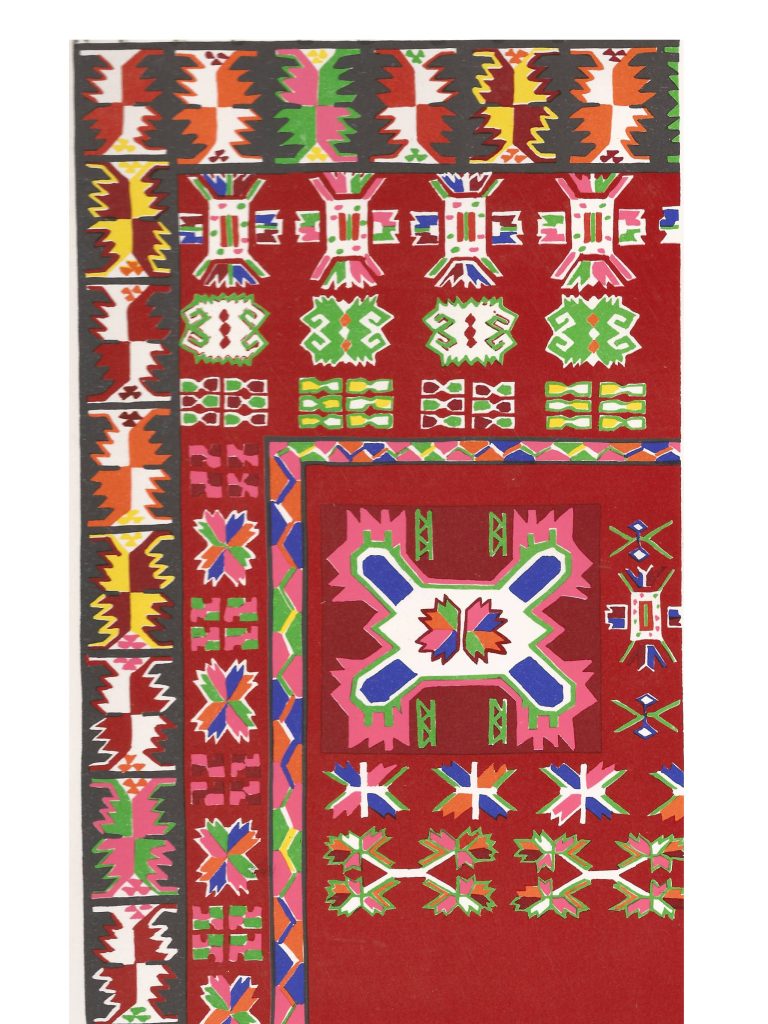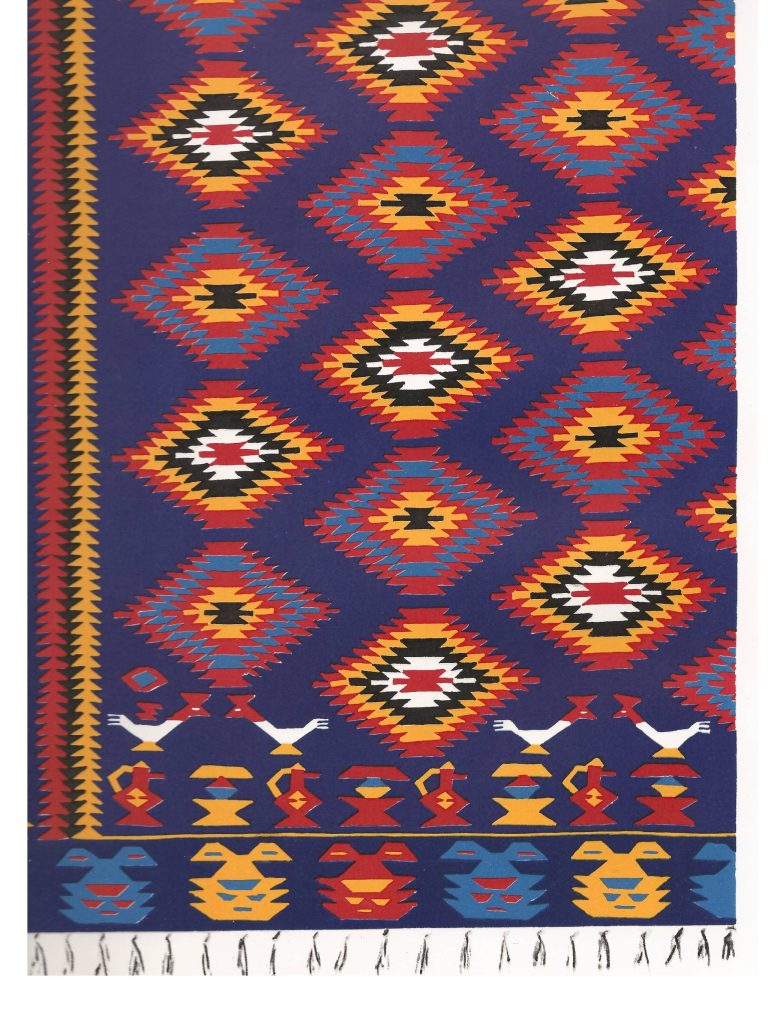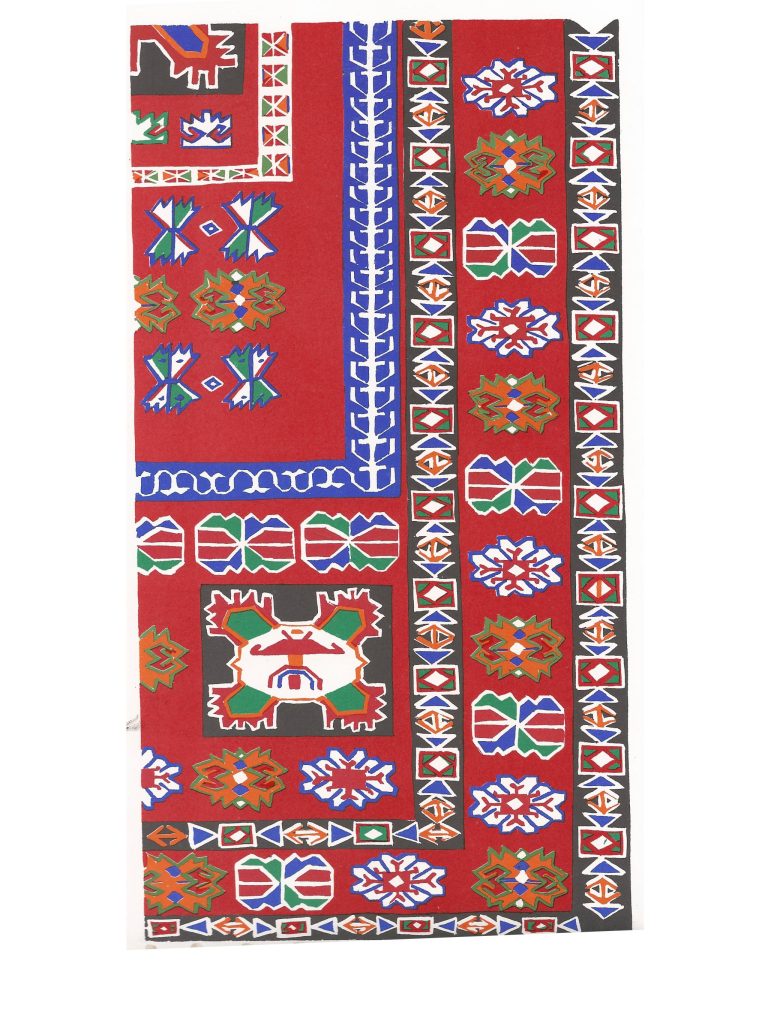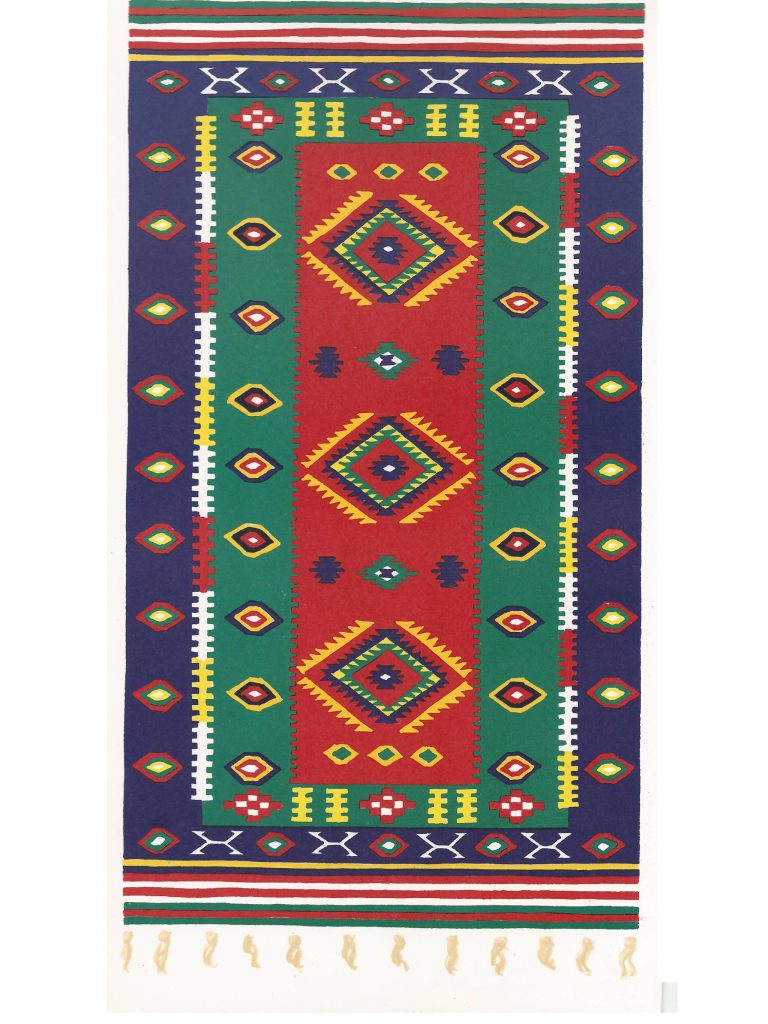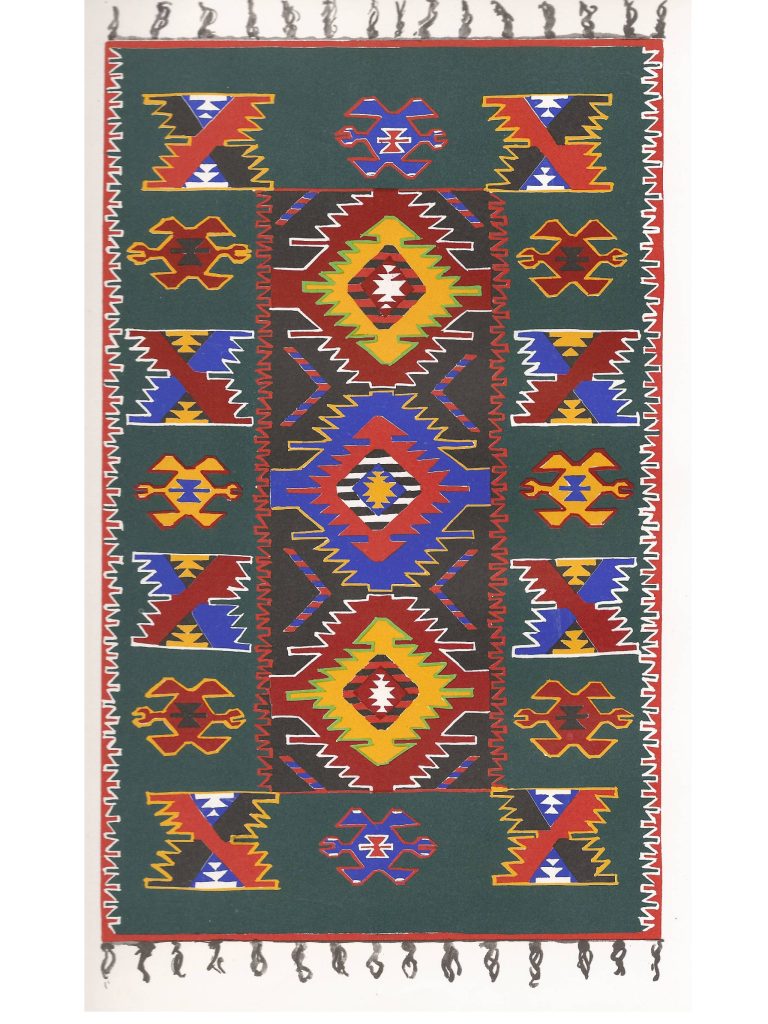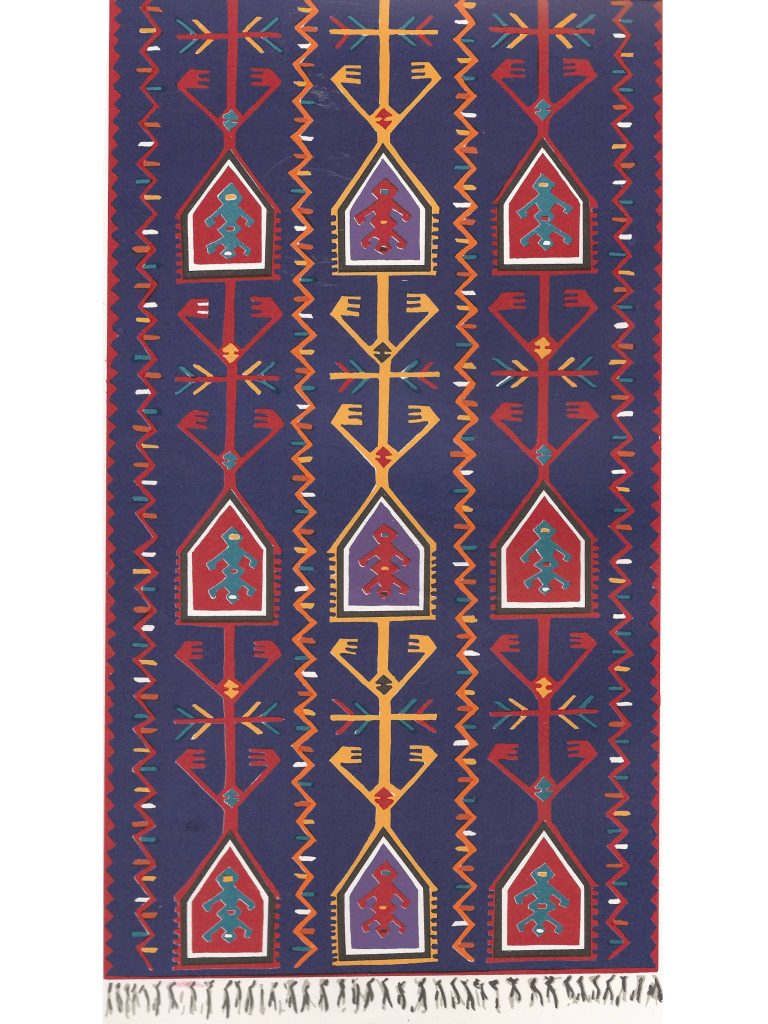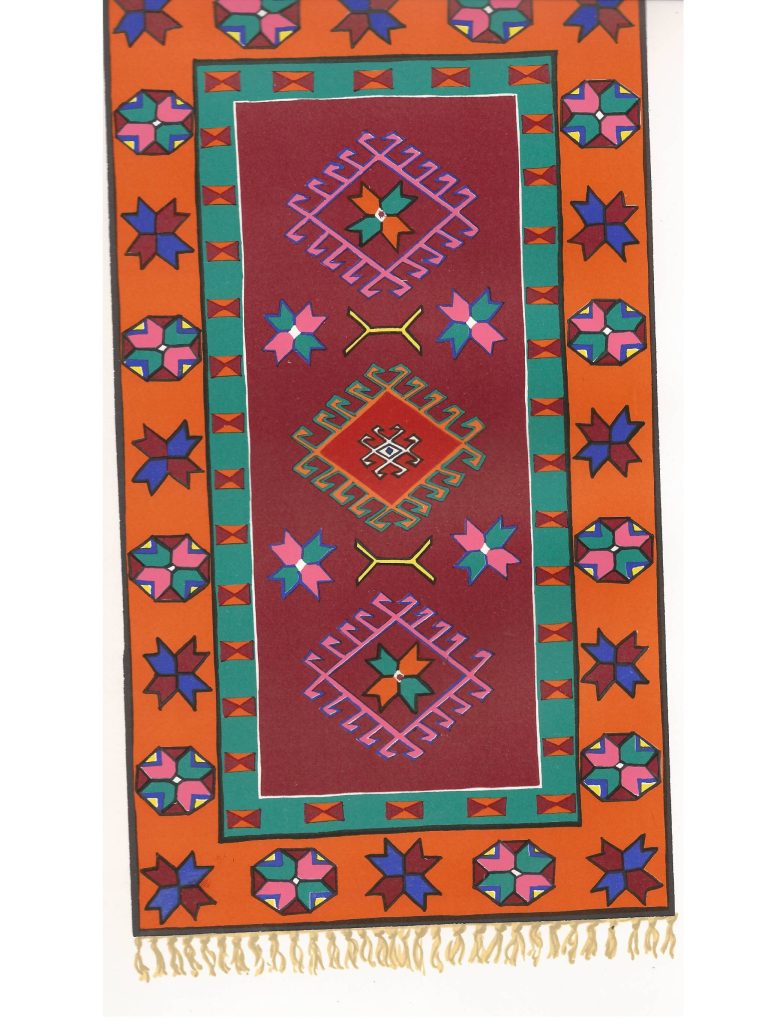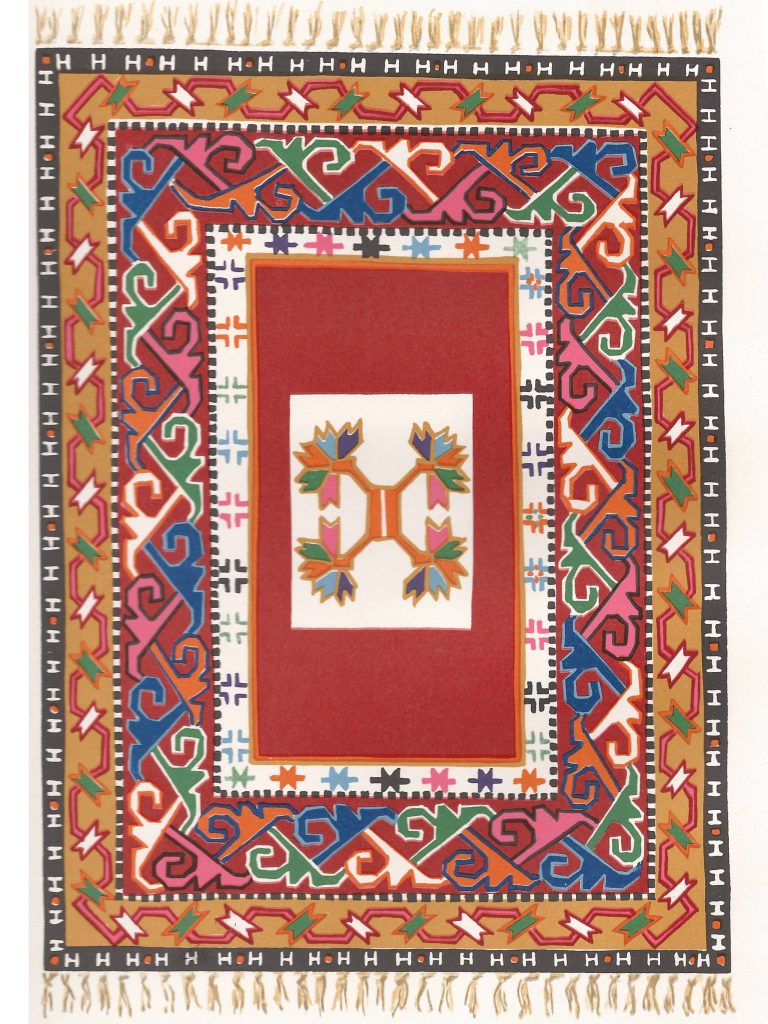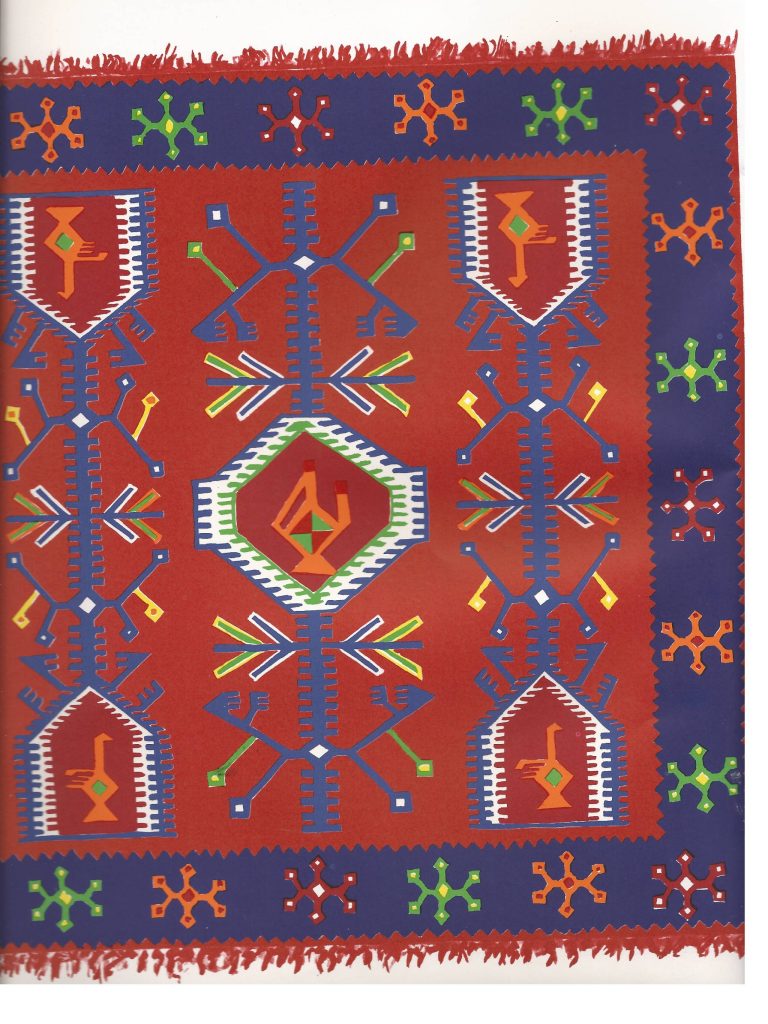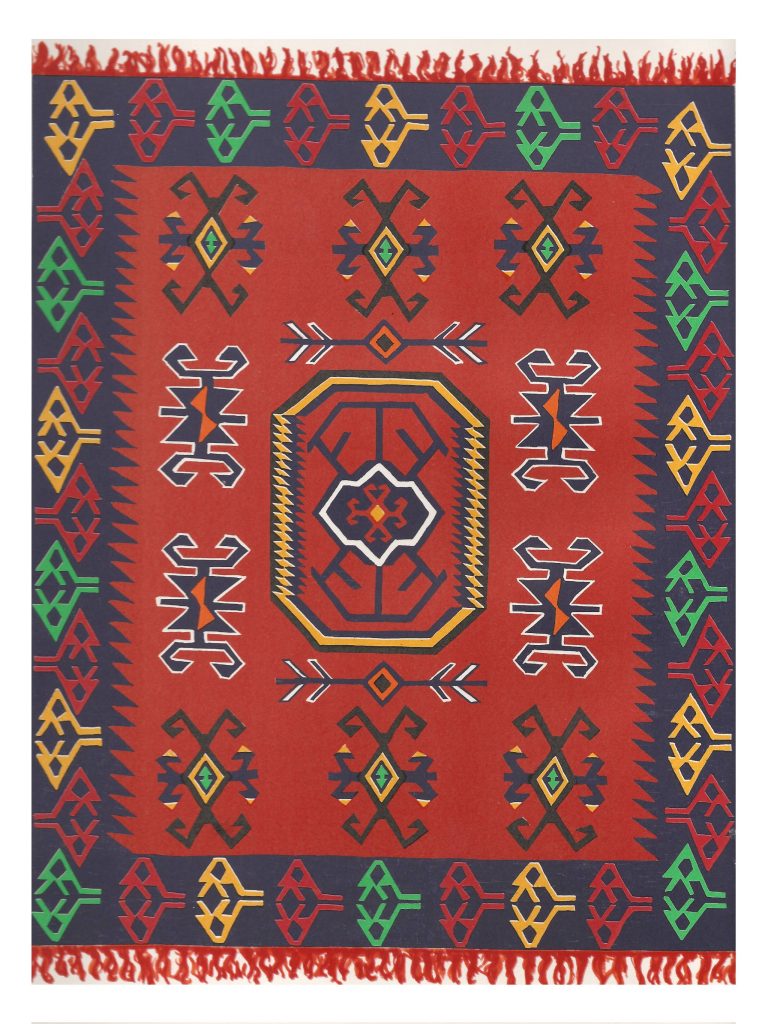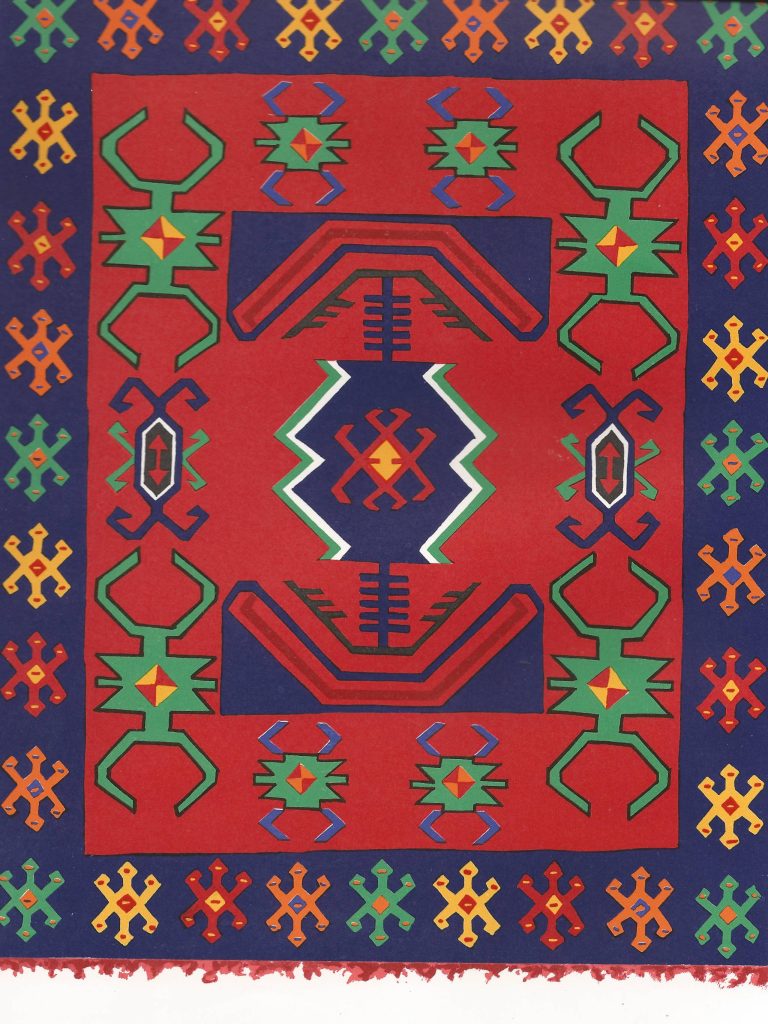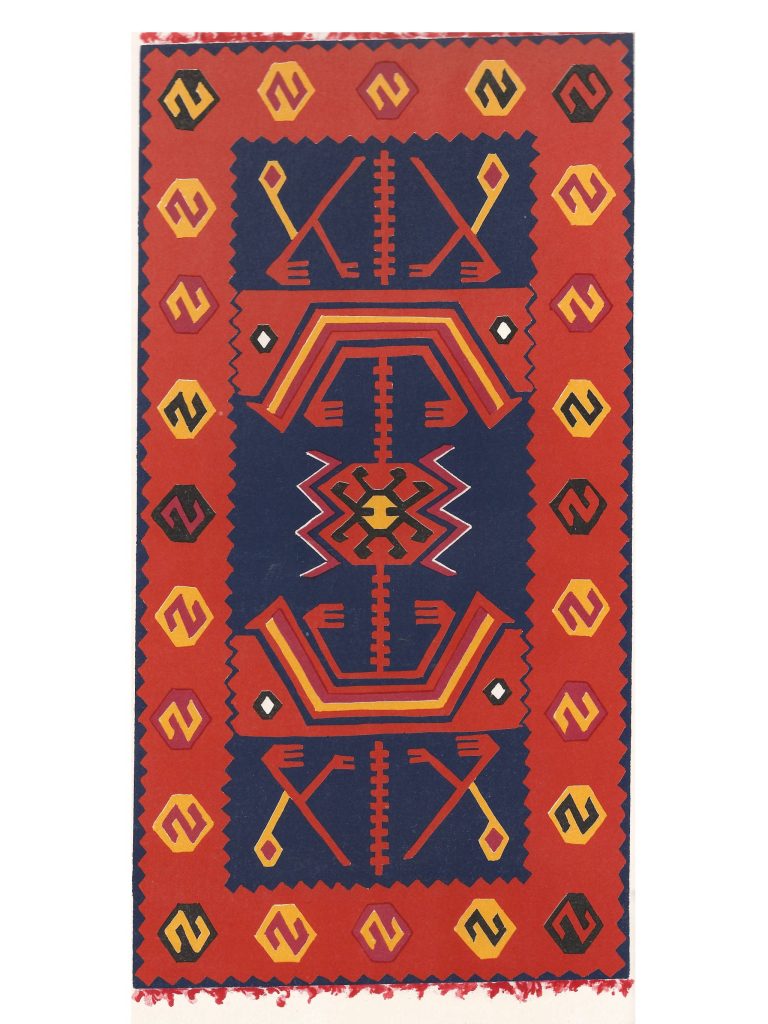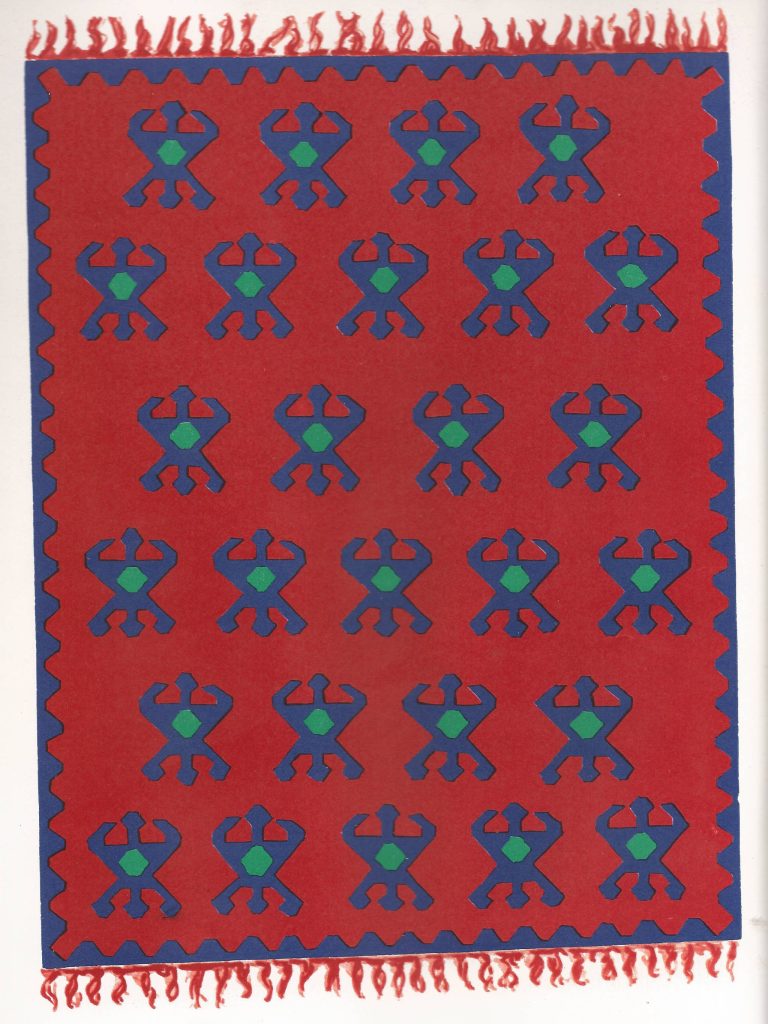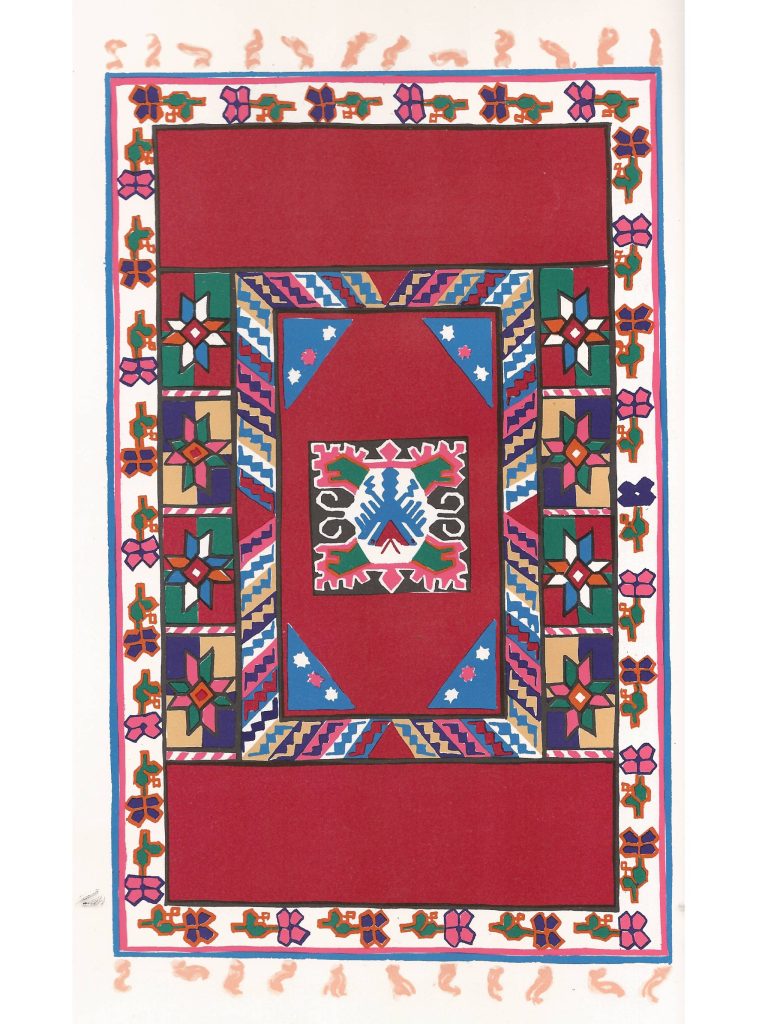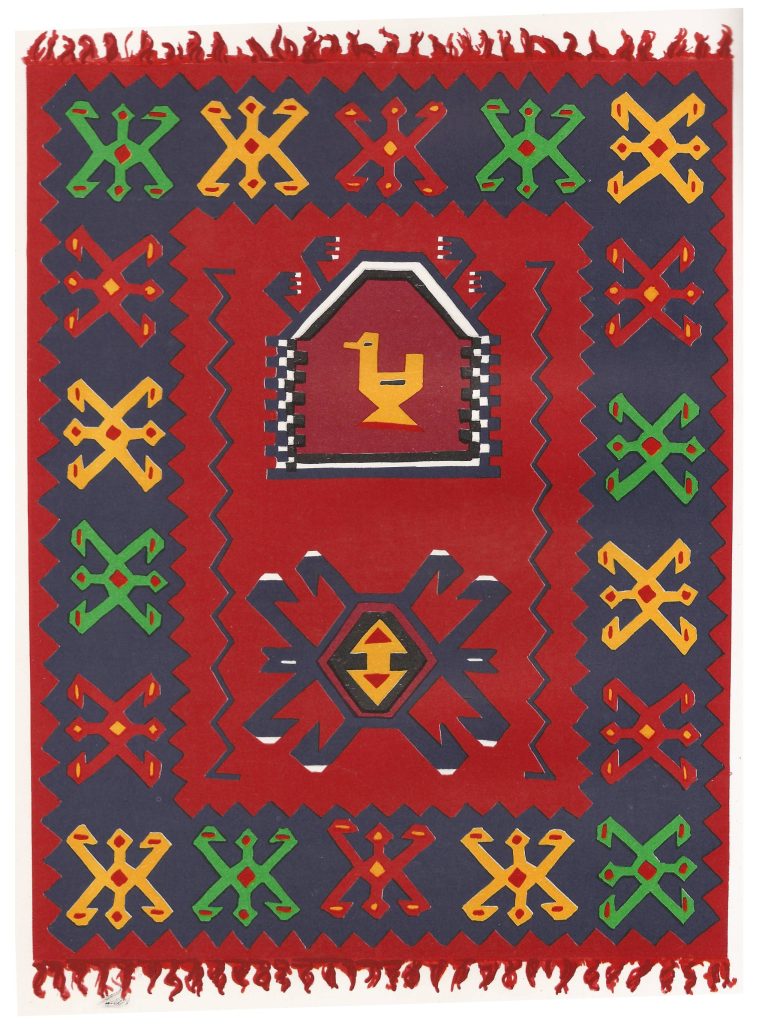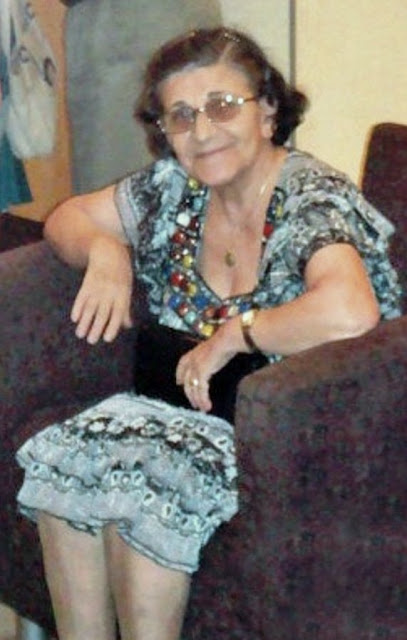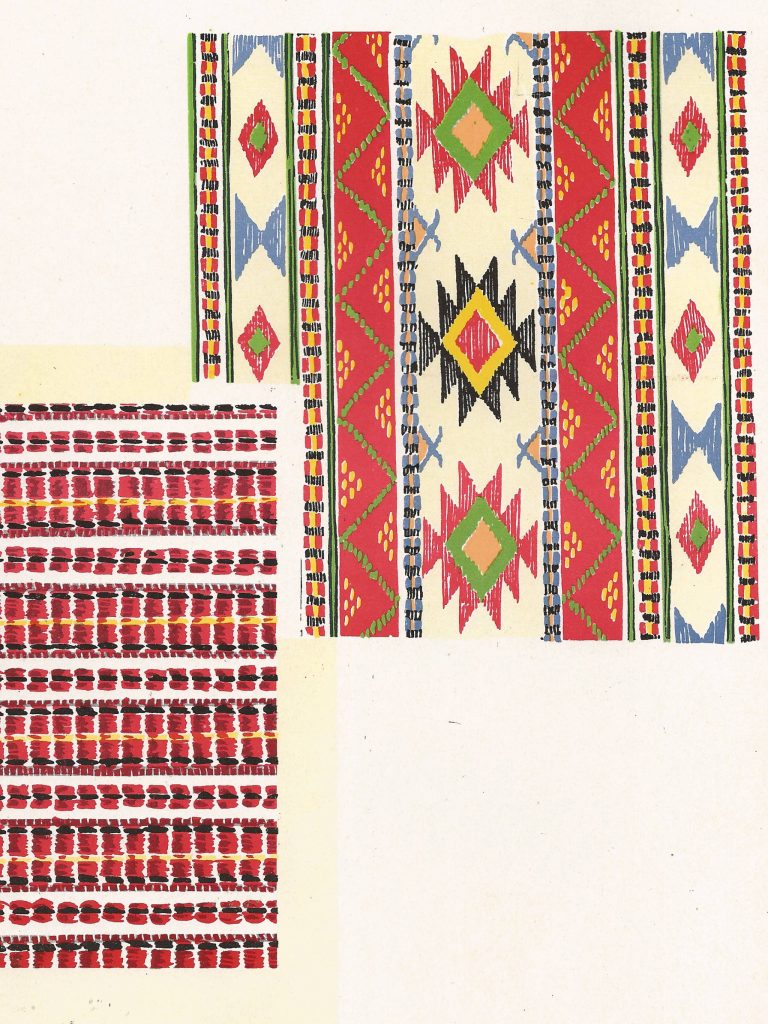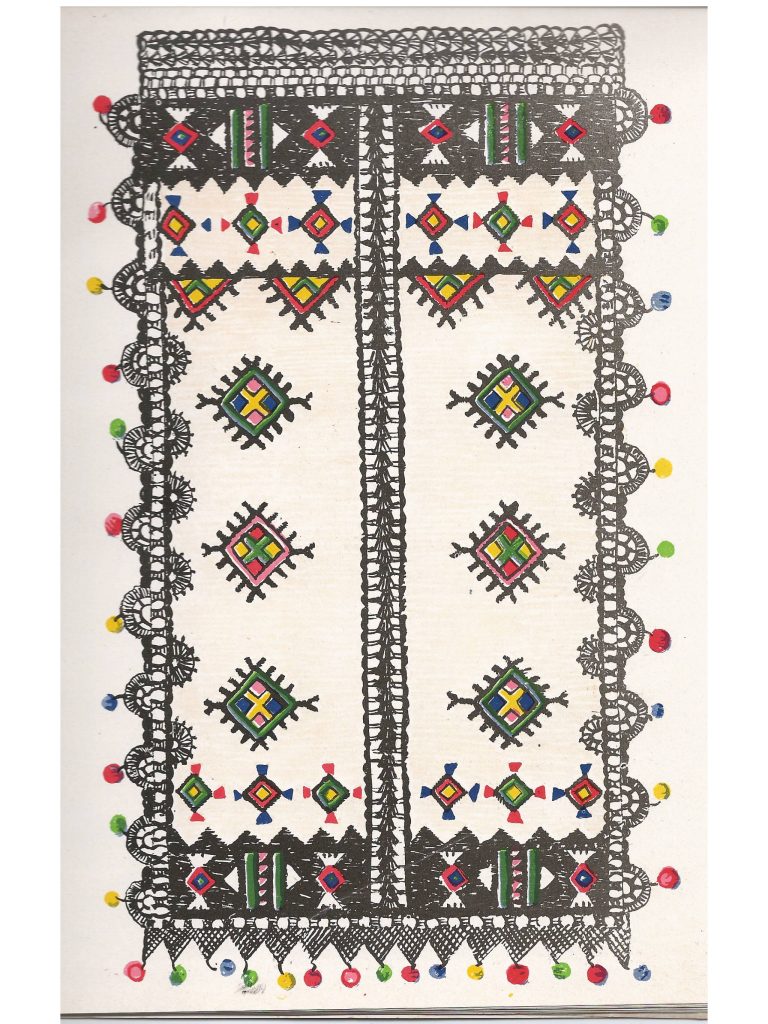If one pays a visit to an Albanian family, especially to one which has faithfully preserved the ancient traditions of people’s culture, the thing that strikes him most and draws his attention a great deal, is the majestic feature of the drawing room. The Albanian, owing to the strong traditions of generosity and guest honoring custom, picked one of the best rooms of his dwelling house to receive his guests. In order to offer the guest the most quiet and pleasant stay in his dwelling, to create a warm and intimate atmosphere in the drawing room.
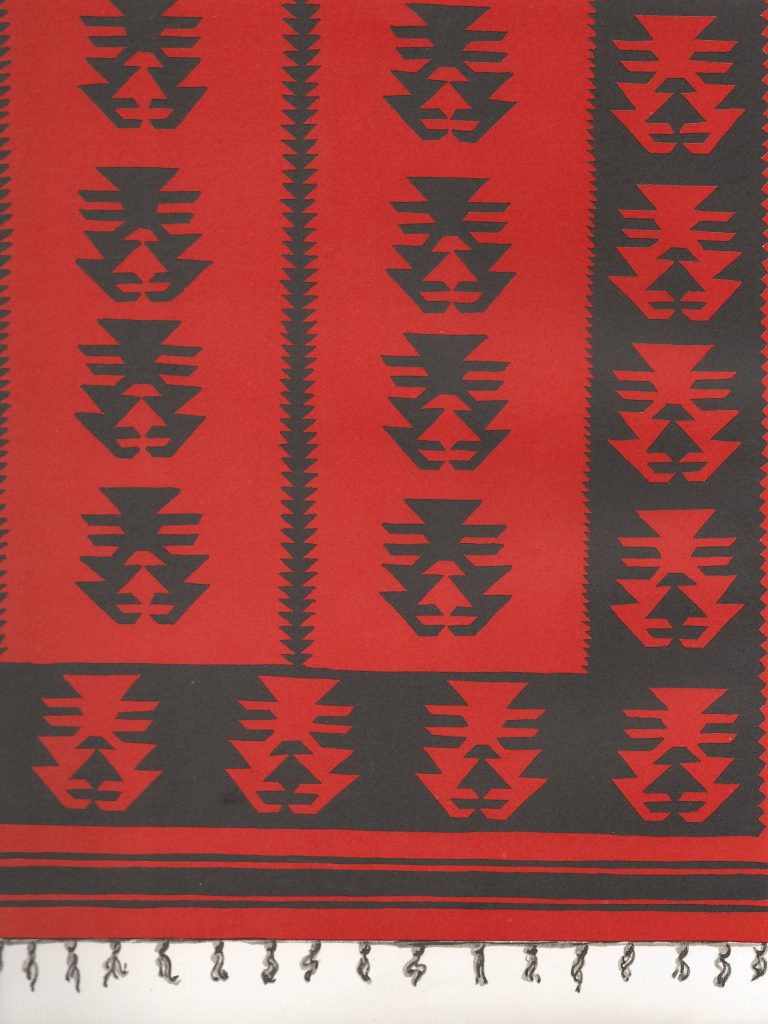
29. Carpet from Kosovë
18. Carpet woven in Kosovë

The Albanian couple, in close collaboration with one another, did their best to furnish this room in the best way possible and make it most attractive. The Albanian drawing room resembles a small exhibition of the people’s art: in whatever direction you throw your eyes, be it the ceiling or the floor, the walls or the windows, you will note that it is well-set and richly decorated with objects worked out with great taste and distinguished artistic talent.
But besides all the various objects used to decorate the drawing room wood or metal, stone or gypsum plaster, its floor set is marvelous. The floor covers of the Albanian room, worked out of a selected material with perfect technique, with a treasure of lively and string colors, sweetly combined, with a treasure of designs combined in a harmonious way, appear as artistic works of a high quality.
The Albanian Carpets
The State University of Tirana
The Institute of History and Linguistics
The Ethnographic Section
Year published: 1970
Author: Rrok Zojzi
Rrok Zojzi (Shkodra, 16 November 1910 – Tirana, 1995) was an Albanian etnografer and ethnologist. After receiving secondary education in his hometown, while working as a teacher, he was also engaged in mountaineering, research, geography, and especially in the field of ethnoculture.
In1947 he was appointed as the head of the ethnography sector and he led this sector until his retirement in 1976. He worked closely with Dom Frano Illina, who, although he was not a collaborator of the Ethnography Sector, deposited the Kanun of Skanderbeg in the archive of the Institute of Popular Culture.
Ikbale Bihiku
Decorator of the ethnographic section in the history and linguistics institute, 1970, Tirana.
Here you can find further scans and work by Bihiku:
www.flickr.com/photos/bihiku/
From the book:
The Albanian Carpets
Though the room equipment is quite common to our people, and this tradition stands at high level, no attention has been paid till now to any publication on the collection or study of this material. It is for the first time that comrade Ikbale Bihiku, a decorator of the ethnographic section in the history and linguistics institute, appears to the Albanian public with a number of articles collected from Albanian room equipments. The material included in this first edition, is partly drawn out of the existing one in the above-mentioned section and partly collected by the author during her various expeditions. The inclusion of this material in one volume isn’t only a very valuable contribution as a study material, but it will also serve to popularize and further develop these traditions. We congratulate the author and hope she will continue her work of collecting and publishing material of the popular creativeness, as with such a work she will render a great service to our country and people.
On the occasion of the very first publication on Albanian house equipment, we will make an ethnographic criticism of this material.
I. The general qualities of the Albanian floor covers of the rooms
The tradition of setting the covers on the rooms exists in all Albania: with a very few exceptions, the drawing room of every Albanian family, both in the lowlands and in the mountains, in villages and towns, is very well set. If we throw an eye on the various covers in daily use by our people, we will notice among them combinations of forms and colors, of weavings and windings on different pieces, which vary in type, with no connection among them. But if we make a scientific analysis and make a thorough study, we will find common elements among them, organic units which form groups and sub-groups each containing a series of distinctions. The tradition of the room settings of the Albanian people is very old: their primitive forms which in some places exist even at present as remnants of the distant past and the numerous remnants of the long chain in the historic process of their development which left its footprints in various districts of our count, aire a testimony of ancient epoch.
Through the observation of the forms of the Albanian primitive room settings still existing here and there, we discover the common basis, the old cover of all the various room settings used nowadays by our people since the common origin up to the present, the tradition of the Albanian room setting traversed the great period of the centuries, thus being inherited by each successive generation, rising and developing in the conformity with the economic and social progress and development of the people.
As the economic and social progress of our people did not proceed in a unique form throughout the country, the tradition of the room setting did not rise everywhere in the same degree of progress; while in a district we still find remnants of low forms of development, in another one we find more advanced forms. These different features in the developing standard of our room setting, assumed a great change among them. Besides the changes caused by the level of progress, among the Albanian room settings changes were noticed even in the special conditions of life between one district and another. The geographical changes of the country brought about changes in economic resources; the changes in the climate required changes in the house commodities, etc. These particular conditions of life necessitated local changes in the people’s culture which also were reflected in the house. On the other hand, as long as such articles were produced within the economy of the family and for their strict necessities, every Albanian woman, expresses, in her work, her individual feelings in the combination of the colors, in the creation of the designs, etc., thus creating a big gradation of light and family shades.
[end page 1]
The mutual influence between our people and other peoples noted in the floor covers should also be mentioned. Just as in Language and in any other aspect of culture foreign elements can be found coming from abroad, in the Albanian room commodities elements imported from other peoples can be found, which influenced country designs. These foreign elements we find in the Albanian room commodities do not eliminate the national character, possessed by our people in house commodities, for not only this influence amounted to a minimum, but it assumed an Albanian form and the nature of the ornaments existing in our traditions. The common and special elements found at the same time beside one another in the Albanian carpets make their study very interesting. The common elements, which are a consequence of a common and very old cultural level, witness the ethnical unity of our people; while the special elements which penetrated during many centuries witness the historical process of development, the particular conditions of life between one region and another, as the foreign influence in the traditions of our peoples culture. We can derive, through an analysis of these elements, the origin of the Albanian floor covers, the historical process of development and their national character.
II. The common and special name of the Albanian floor covers
There isn’t a common term with a generic meaning in the Albanian language to be used for all kind of objects used to set the room, irrespective of the material they are made of, the producing technique, the form and the decorations they contain.
In some regions the word “qylym” is used, in some others the word “sexhade”, “sexhade” or “sex-hade”, somewhere they use the word “hali” and somewhere else they name it “storme, in some parts of Albania the world “cull” is used while in some others they say “shko”; there are people who also name them “mesele”, “plaf”, “cerge”, “floke”, “loxu”, “mutaf”, “tepik”, etc. These are all terms used with a general meaning for any object serving as a cover for the floor. These different terms which in some cases are used by our people in a general sense, do not have such a meaning, but each of them has a special meaning for one sort of floor cover which varies from others because of the particular elements it contains. These terms of a special meaning often assumed a general meaning as people of one region of the country know and use only one kind of carpet, and that’s why they name any other object of the same use with the same term.
In order to do with this lack of our lexicon, we are going to use in this analysis the term “shtroje” (cover), derived from the verb “me shtrue” (to lay, to set, to cover) in a general sense, while the other terms will be used with their meaning of a series of sets or of a particular set as it will be deemed necessary, just as the people use them in various regions who know the difference.
The generic term “shtroje” (cover) which assumes the meaning of the floor covers of the room, has been introduced as the new term in our language and particularly by the people of the towns. This term was also used in the distant past, but it had another meaning. Although our city inhabitants use the form “me shtrue” (to lay), and “me çue dhomën” (to remove the room), with the meaning of covers for the floor, in the past as well as now in the countryside, “shtroje” (cover) is used with the meaning of the bedclothes “shtroje e mbuloje” (mattress and coverlets – all the things used to lay a bed). When beds began to be used, thus making it unnecessary to lay the mattress and everything needed for sleeping, the term “shtroje” was more closely linked with the floor covers of the room.
The close connection expressed by the name “shtroje” between the floor covers and the sleeping things is found even in the object itself as it will be seen in our analysis.
Ill. The Origin of the Albanian Covers
To be continued


